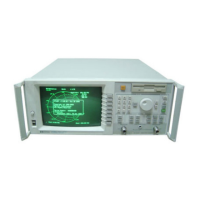I
-
I
-
Measuring AM Delay (Option
IDA
or
1DB)
An AM delay measurement characterizes the group delay (or envelope delay)
of a device.
lb
perform this measurement you must have ordered either
Option
1DA
(AM Delay, 50 ohm) or Option
1DB
(AM Delay, 75 ohm). These
options include internal instrument hardware and firmware, two external
scalar detectors and a power splitter.
Group delay flatness can be a key specification for many components and
systems. Distortionless transmission of a signal requires constant amplitude
and group delay response over the frequency bandwidth. Group delay is the
measurement of signal transmission time through a device. It is
defined
as the
derivative of the phase characteristic with respect to frequency.
If the device under test is a frequency translator, the device input and
output frequencies will by deiinition be different. This generally makes the
measurement of the device phase response (and therefore group delay) very
difhcult.
The AM Delay option overcomes this
dilhculty
by using an amplitude
modulation technique to measure group delay. In this technique, a small
amount of amplitude modulation is applied to the RF output of the analyzer.
Scalar detectors are used to detect this modulation both before and after
the device under test. The group delay can then be calculated from the
phase difference between these two signals (modulation envelopes). Since
broadband detection is used, the Option
lDA/lDB
analyzer can measure delay
through nearly any device, including frequency translators.
There are several important considerations in an AM delay
measurementIf
the device is a limiter or has AGC (automatic gain control), this will tend to
distort or remove the amplitude modulation used for the measurement. Any
limiting or AGC in the device should be disabled before making an AM delay
measurement. The broadband detection used for AM delay is susceptible to
spurious signals and noise. High-level spurious signals should be removed
with altering. The signal levels at both the reference and test detectors
should be kept as high as possible. The
speciiied
incident power range for
both detectors in an AM delay measurement is
-
10 to + 13
dBm.
If the
device input power must be outside this range, amplification or attenuation
must be used directly before the device. If the device output power is outside
the
-
10 to + 13
dBm
range, attenuation or amplihcation must be used directly
after the device.
3-42

